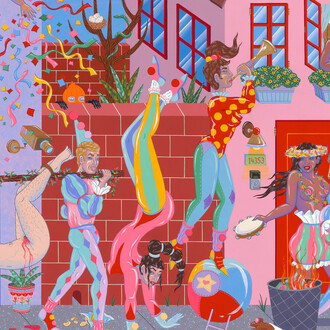The city burning is Los Angeles’s deepest image of itself.
(Joan Didion)
Ed Ruscha finished his seminal painting The Los Angeles County Museum on Fire in 1968, and a half century later his searing depiction of the original LACMA campus seems prescient as the buildings captured in that painting are set to be demolished for a new superstructure designed by a Swiss architect who is fond of, ironically, incorporating charred wood into his designs. Of course, fire is a cleansing mechanism, and its regenerative qualities burn bright in the practices of countless Los Angeles artists, perhaps because many, if not all, of them—especially those who have lost homes, studios, archives or more to wildfires historic and recent—live with the existential threat of these conflagrations touching them year after year after year.
Throughout modern history, westerners have been drawn to fire as a result of failing to learn, as UCLA professor Daniel M. T. Fessler argues in “A Burning Desire: Steps Toward an Evolutionary Psychology of Fire Learning” ( Journal of Cognition and Culture ), how to properly play with and control this seductive force of nature. Rather than aiding the ecological expression of fire’s natural trajectory we seek to suppress it under our capitalist domain.
The same psychology may be guiding our compulsion to reside in such inhospitable climes: LA being a prime Stateside example with its megafires, fault lines, drought, pollution, population density, and homeless epidemic. Still, new Angelenos come to bear witness each year, and each year the fires get worse. But literal flames—to say nothing of the broader perils of climate change— are only one example of “fires” perennially burning in LA. Water wars, racial tensions, police brutality, gentrification, economic disparity, future creep, political corruption, Hollywood dreams and Skid Row nightmares are all looming threats. These fires have been burning for decades, and for decades LA artists—from Chris Burden and Lita Albuquerque to Karon Davis and Juan Capistrán—have responded to them via photography, painting, sculpture, performance, installation, sound, and video work in the modes of realism, abstraction, and conceptual gestures.
This is the thrust of L.A. On Fire , a multimedia group show curated by Michael Slenske at the newly expanded space of Wilding Cran Gallery at 1700 South Santa Fe Avenue. The show’s title derives from a photo series, featured in the exhibition, by French artist Michel Auder. Along with the work of more than 50 emerging and established LA artists, this titular work investigates the possibility that LA has gone from Tomorrowland to an Ever Burning Bacchanalia. And in this moment of Nero-esque nihilism, we can’t look away as we watch our house(s) burn down: LA is literally on fire and 🔥🔥🔥 in the same moment.
The exhibition also repeatedly addresses Didion’s conceit: that fire is (and perhaps always was) the truest expression of the LA landscape. Just as the frequency of headlines warning of the next inferno have shortened from monthly and weekly to daily and hourly, CalFire’s 2018 Strategic Fire Plan asserted: “Climate change has rendered the term ‘fire season’ obsolete.” In other words, the fire is the landscape and you can no longer separate one from the other. Though maybe there was never a fire season to begin with. Maybe LA’s fires—just like those which have ravaged the Amazon, Western Europe, and Siberia in recent months—never stopped burning and maybe they never will. If anything, L.A. On Fire is meant to serve as an artist’s perspective onto both possibilities.
A portion of profits from LA On Fire will be donated to The Climate Emergency Fund.
















